It looks like a hot day; a lot of water is splashing around and the view is not clear. As the splashing subsides a bit, a bunch of kids of varying ages are briefly visible, playing in water, and hold on, this is not a swimming pool, it looks like a lake or a river. Just as I am beginning to recognize the scene, it dissolves, and a new one appears, this one with a bunch of playing cards that kids are playing with. Again, the scene goes in and out, and suddenly turns into a screen of golden yellow. While I am wondering what this is, I can smell a delicious and familiar aroma, which makes me smile, as I slowly recognize it. I am now very eager to pick on that golden yellow object which has titillated my taste buds and I stretch my hand out. Strangely, I feel nothing but air against my outstretched fingers. I blink and look – all I see is my hand stretched out towards the ceiling fan above, and I realise I have been napping on my bed, which means this was a….. dream.
A dream? I am not one to remember dreams much, so I continue to lie on my bed, trying to make sense of what my mind just saw, before it vanishes from my conscious mind. I quickly recognize the river setting I had seen– it’s the village where my maternal grandparents lived. I can’t yet figure out the playing cards – I only played cards during school holidays. The rest of the images are blurred but what I can still remember clearly is that golden yellow screen. My mind is whirring now like the ceiling fan above me – what could all this mean? How are these images connected, for connected they must be, else I would not see them together in this way. Some quick mental work quickly puts the pieces together to realise that these scenes were all images of summer vacations from my childhood – the quintessential two-week vacation at my grandparents’ house in a little sylvan village on the western coast of India, the playing cards which came out only during summers for afternoon entertainment, the fun and din with cousins – beautiful memories of blithely blissful times. These are treasures that I have happily reminisced about many times, but always in full wakefulness. Why then, was my subconscious so full of them now, that it was projecting them in my dreams? This was unusual, even weird, so I mused on about it to dig further.
And the answer came to me in a flash – that golden yellow screen with that sweet aroma – the alphonso mango – the final flourishing finish on all summer vacation fun, my favourite fruit that I would wait for all year. It’s end of April as I write this – the time of the year when, going by every single year of my life so far, I should have been gorging on mangoes. This year has been different though, a little virus has made it so. While dealing with all other visible and more important effects of this change, this differently important annual event had been forgotten. This is my first ever mango-less summer. (Who would have thought this possible?) While my conscious mind had relegated the thought of mangoes backwards given everything else that’s happening in the world, and while outwardly I did not think of it, clearly, my subconscious had it right on top. Also, quite clearly, in my subconscious, I have been craving for my favourite Alphonso mango! Amused by this realisation, I allowed my mind to indulge in a trip down memory lane (the only trip I can take in these circumstances) to savour memories of the mango, to savour its indulgent taste, texture and flavour vicariously, by remembering every form in which I enjoyed it and every dish which it sweetened – my tribute to King Alphonso!
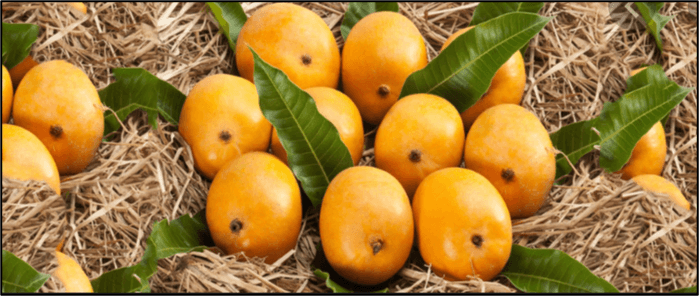
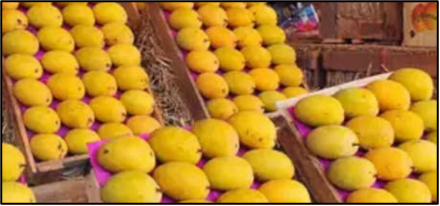 Summer in the western coast of India is the hot sultry season before monsoons, spanning roughly from mid-March to mid-June, the perfect season for mangoes. The alphonso or “hapoos” mango as it is called locally, is among the most popular varieties of mango in India, often called the “king of mangoes”.
Summer in the western coast of India is the hot sultry season before monsoons, spanning roughly from mid-March to mid-June, the perfect season for mangoes. The alphonso or “hapoos” mango as it is called locally, is among the most popular varieties of mango in India, often called the “king of mangoes”.
Mid-April and May are peak months for this fruit to grow into its full golden ripeness, and fruit markets all along the west coast of the country take on a golden yellow hue as this fruit, neatly packed in hay-laden boxes, gets disproportionate space in fruit-grocers’ carts, menu charts and people’s hearts.

Before I get into its culinary delights, for the uninitiated, let me give a brief introduction to the Indian alphonso. Mangoes are native to India and have always been much loved for their unique flavour and juiciness. The Indian mango was however, a soft and fluffy fruit, which suited the dishes and eating habits of native Indians, but was too messy for Europeans when they arrived in India in the fifteenth century. The Portuguese colonists who settled into the western coastal parts, wanted the fruit for its flavour but also wanted it in a form that could be easily “cut and served” at their dining tables. They experimented with the fruit and from those experiments was born the “hapoos” which the Portuguese named after their Viceroy Alphonso de Albequerque. The Portuguese left India in a few centuries, but the Alphonso will rule over the hearts of people forever.
Ours was (is) a mango-mad family – and while all types of mangoes are welcome, the hapoos is the undisputed favourite. Every March, we would eagerly await the arrival of mangoes, and from the first mangoes that hit the market to the very last, my father ensured that our pantry never ran short of them. Mangoes made it to the dining table at every meal and in between, in every shape and form possible. And today, as I lay on my bed, I was tasting them in my mind all over again.
The best way to savour a mango is just in its pure form without any additional flavouring – we had many ways in which we would do this. The simplest, quickest and yummiest way to savour
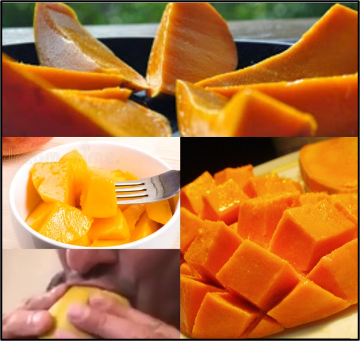
From left bottom upwards clockwise : (1) sucking on a mango; (2) diced mangoes in a bowl; (3) cut in long slices (4) diced mango
a mango, albeit the messiest, is to loosen the pulp from the outside (without cutting or peeling it) and then to suck it up straight from the fruit – an art that needs to be perfected but irrespective of perfect or not, allows the eater to suck and slurp on every bit of the fruit without even opening it. As kids, we would love eating a mango like this, and especially in my grandparents’ house (the same one I had just seen in my dreams), where a room would be filled with nothing but mangoes in the season, freshly plucked, we would just run in whenever we wanted, take our pick of the fresh yield, wash it, pluck the stem, squeeze the sticky juice near it away, and voila, put our mouths to its yummy taste. Mmmm… mouth-watering…slllurrrrppp…
The perfect opposite of this messy way of savouring the mango, was the bowl of neatly diced cubes that our mother used to lay out for us, with small forks (much like the Portuguese) to pick the pieces up and eat in a more gentle and genteel manner. The most common way in which mangoes are cut to be eaten, is along their length, to give nice long slices which are eaten by scraping the pulp off the skin with the lower teeth – giving quite a different texture to the same pulp, as you munch on it. The feel of the skin of the mango as you eat the pulp off it makes for a different eating experience – yummy as well. And then, whichever way you may cut the mango, sucking the juice and pulp off the fleshy big seed is another art. As kids, we would often debate about who sucked their mango seed the driest 😊. Even to this day, I keep the mango seed for the last because I love to polish the last drop of juice off it.
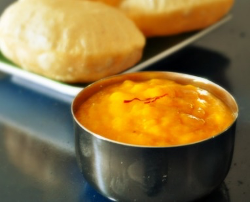
Aamras poori
“Aamras” (mango pulp) used to be a staple in the refrigerator during summers. Aamras is the fleshy pulp of the mango, deseeded and pureed (either coarse or fine), and sometimes flavoured with cardamom, saffron or other spices. It is a special dish, eaten along the west coast of India, either by itself or with bread – rotis or pooris. Aamras-poori is considered a special dish in all the western states of India – Gujarat, Maharashtra, Goa, Karnataka. This is one of my hot favourites, so much so that it was one of the special dishes served at my wedding lunch! With a mango-mad bride getting married in the middle of summer, that was to be expected!
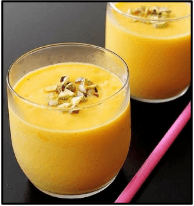
Mango Milk Shake
From aamras, the next simple culinary step is the mango milk shake – it was easy to make, and even as kids, this was one of the first things we learnt to make by ourselves – aamras + milk + some ice in the blender = the coolest drink you could dream of! It used to be freely flowing during our summer vacations, and with the appetites we had at that age, the calories or heaviness of it was never a problem – blessed childhood! Mango lassi is another very popular drink blending mango pulp with yoghurt or butter milk. While I don’t like it as much, it definitely deserves a mention, given its fan following. Then of course there were fruit salads or even other salads that tasted heavenly with the addition of this fruit. Another easy-to-make and always-a-delight dessert was “fresh mango with ice cream”, which we partook of freely.
All the dishes I have mentioned so far use mango in its raw form and hence are relatively easy to make; but then, there also are more involved and evolved dishes – we depended more on our mums and aunts for these, but they spared no effort or love in ensuring we had enough of these. Mango juices of different varieties cooled us down in the summer heat. A mango offers a unique combination of sweetness and sourness, which, mixed with spices that abound in India, can be a culinary delight. On top, different varieties of mangoes offer different flavours and
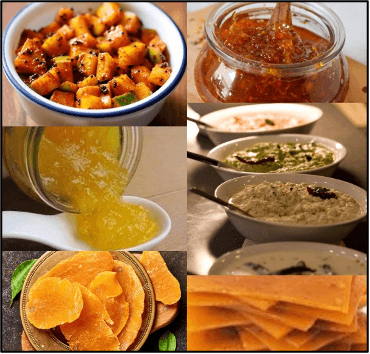
Pickles, chutneys, jams made of mango and dried mango
textures, which are used to advantage in different dishes. Mango curries using the pulp and seeds of mangoes, as well as chutneys, pickles and jams (morabba) of different varieties, all made by different blends and mixes of mangoes with other delectable spices and ingredients concocted some unmatchable combinations of sweet-sour-savoury flavours that made up delightful meals during summers – my
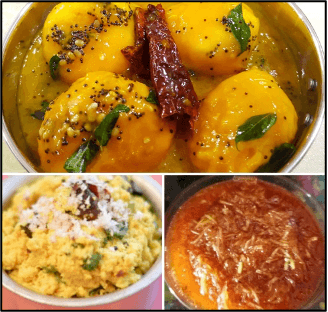
Ambe-upkari, Ambe-Dal; Chhunda
mouth waters by the mere memory of these. The Maharashtrian “ambe-dal” (a dry chutney with raw mangoes and pulses), the Mangalorean “ambe upkari” (a savoury mango curry with whole ripe mangoes), and the Gujarati “chhunda” (sweet-sour mango jam) are yummy all-time favourites of mine. We also ate many small snacks made of dried mango – some sweet, others tangy and many with mixed flavours. Drying mangoes can help store them for a long time, allowing them to be relished long beyond the season.
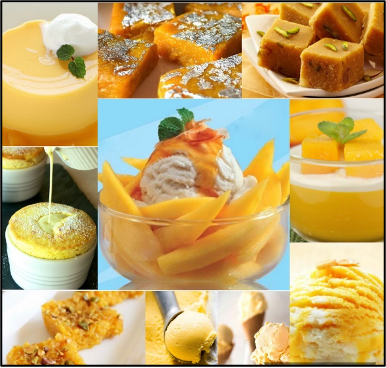
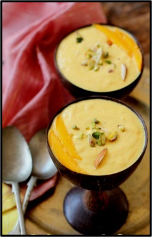
Aamrakhand
Mangoes also made for many types of sweets – milk sweets like different types of mango barfis and pedhas would be available in sweet shops during summers; mango kulfi, ice-creams and sorbets flooded ice-cream parlours; and there was the popular “aamrakhand” – a yoghurt sweet flavoured with mangoes. The flavour of mango puddings and souffles with fresh mangoes was the best in summers. So many ways in which we enjoyed this special fruit, and we relished them all. I am sure there are hundreds more of recipes and dishes way beyond what I know or have experienced. I don’t claim at all to be an expert, I am just a fan drooling over my sweet mango memories.
At any rate, to date, there is no fruit that matches the mango in the way it occupied the plate and the palate of us kids in those childhood summers. We would have our fill of the fruit, as if to make it last and endure in every taste bud until the next summer. And so it has continued year on year; while the gorging had to be pruned down with slowing metabolism over the years, the zest for mangoes has stayed unchanged. Come March every year, the latent mango madness would come out in its most ardent form. Until this year, when, as mentioned, life changed so dramatically, that this zeal like many other quintessential things in life had to be put aside, as other things took precedence. I am so happy though, that my subconscious rebelled and kept that zeal alive at the back of my mind, gently waking me up to it today. Forbidden or not, this fruit has been and will always be the sweetest to me. While indeed forbidden now, I hope to be able to catch it in the next season. I am sure its sweet memories will keep me going and smiling until then. My dear for-now-forbidden fruit “All-fun-so” – I miss you so!
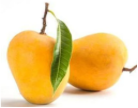
~ Musingly Yours


Very aptly written. Masta vatla vachun ani tondalaa pani sutley . Really related to it. Thanks for taking us down the memory lane of innocence and sweet childhood memories! 😊👍
I remember one of the years- at the start of the season the price was Rs 800 or so. Your comment price was not to be considered in mango matters. Your story brings that out very clearly. Nice reading.
Thanks, Harry!
Most welcome, Pramod – that memory lane is a very special one. Thanks for your kind comment!
Remember my days when grandmother and mother used to make mango pickle and chunnda and would be kept in sun for number days.
Very well written and brought back our memories with grandparents
Thank you, so much!
Very beautifully wriiten and again hats off for your thought of process
Thanks so much, Sudha!
Beautifully written ,hats off for thought process
A very well written article.
Reminded me of my childhood summer vacations at my mama’s (mother’s brother) house in Poona.
We used have a fantastic spread of mango varieties – Haapus, Payri, goti, et al.
Those 8 – 10 days we would be just gorging on mangoes & more mangoes.
And speaking of Poona who can forget the famous Chitale’s Aamba barfi!
Yummy!
Thank you!
Vaishali this is incredibly amazing and brings back very fond memories of my Aji and my parents who used to ensure a Hapoos bonanza in summer with all of the family visiting us in Mumbai and with all kids sat on newspapers eating mango after mango with delight written all over our faces! It’s the king of mangoes indeed and your article is equally amazing! Keep it up!
Omg…. I am rushing to the shops now…. oh but wait..have to wait longer….. and while I wait, reading this over and over again, so beautifully presented and written.. thank you for sharing Vaishali.
Thanks so much for your kind comments, Vineet!
thank you so much Vikram. I am glad it took you down memory lane too 🙂
Hi Vaishali
Your writing style paints vivid memories of childhood spent with grand parents who brought me up. They would plan ahead of the mango season to ensure the fruit was served in all its forms to the larger family when they visited during vacations. As Gujjus would say that was majja ni life!!
Happy musings.
Regards
Sooraj
Masta… Beautifully expressed
Thanks, Shashank!
Bhabhi your mango musings brought back memories that were lost in the hustle bustle of daily routine crap which we term as our busy lives . Your blog leaves beautiful thoughts of my fav fruit ” the hapoos ” and the umpteen ways we can relish it , loved reading it .
Thank u for taking me back to when I really lived a mango life .
Warm regards , Asif .
Thanks so much, Asif bhai, for your kind words. Glad to hear it took you back in memories 🙂
Vaishali,
This article almost complete me to break the stay at home order in NJ and head to the nearest Patel store! My childhood, my summer afternoons were spent on mango trees plucking raw mangoes in Mumbai while keeping a watchful eye for the Gurkha 😄. Also playing amli Pipili – a cat and mouse game but played on mango trees. Thanks for reviving those memories ! Very well written 🙏🏼.
Thanks, Kunal. Mango is such a common and shared passion, it’s amazing how many people can relate to it! 🙂
An Ode to all things Mango! Beautiful writing Vaishali and indeed – delicious!! Keep the creativity going, my friend – but are Finance people meant to be such wonderful story tellers? Hum marketers ka Kya hoga ?! 😊
Nicely written Vaishali. Brought everyone’s memories back. Superb👍😊
Thank you!
Beautifully penned Vaishali, such mangolicious sweet memories of childhood days.
After we moved out of India 25 years ago miss eating the “ Hapoos” have to be content with the Mexican grown varieties here.
In the last few years we have relished some good mangoes in the summers but nothing can beat the taste of the Alphonso , although the taste still lingers in my mouth with the sweet memories 💕
Thanks, Sharmila. I agree, nothing to beat the taste of the Alphonso.
Very evocative and beautiful written!
Thanks, very much, Rachna!
Beautiful. Felt like i was there in the village eating mangoes
Thanks so much, Rachna!
Hi Vaishali,
Loved how you have beautifully cobbled together memories of your childhood mango season, at the same time informing and educating folks on mango history and mango eating.
May your forbidden-fruit dream come true.
😊